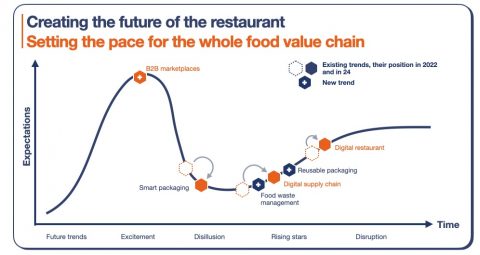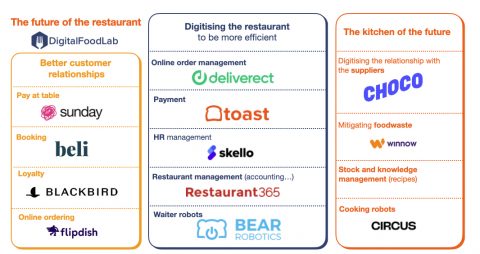Restaurants don’t get the same attention as other areas of the food value chain when considering innovation. Owners prefer (quite understandably) to talk about what’s on their plates rather than what’s happening in the kitchen to make the operations more efficient. However, the future of the restaurant is something really important for the whole value chain as most food innovations, either in the food products, digital services, or ways to interact with customers and suppliers, start inside restaurants. Indeed, they are small, agile operations keen for innovation to supply them with a competitive edge.

As shown above, there are trends all along the innovation curve, from digital tools used by most restaurants nowadays to B2B marketplaces, which are still emerging (more information on trends shaping the future of food in our trends report).
These restaurant trends are all answers to the three challenges that restaurants are already facing:
- Rising demand for more sustainability, notably through food waste management;
- Lack of labour in developed economies, which is answered by offering benefits to employees, better HR management, and, in the long-term with robotics;
- Providing healthier and more transparent items to their clients (even if compared to other food categories, consumers are less impacted by these demands as clients tend to see restaurants as places of indulgence).

If we look in depth at the different categories of players setting up the future of the restaurant, we identify three main challenges:
1 – Creating better relationships with customers
- 📱 Booking a table and restaurant discovery: the “ancestor” of FoodTech with startups such as The Fork and Open Table. New players have recently been trying to reinvent the customer experience with new apps and services.
- 💻 Online ordering services are helping restaurants manage their online presence and also create their own takeaway and online delivery services.
- 💳 Pay-at-table startups emerged in the post-COVID world as an obvious solution to the lack of workers and our desire to limit interactions. However, their success is quite limited compared to the investments that went into their development.
2 – Digitising the restaurant
- 🏧 Payment services, HR management, and restaurant management startups operate along blurry lines. While there are specialists in each category, these mostly mature players are now becoming one-stop shops offering all the features a restaurant needs.
- 🛵 Online order management: as the number of restaurant delivery platforms increased, so did the number of tablets in restaurants. Startups such as Deliverect appeared to manage orders from all sources.
3 – Creating the kitchen of the future
- 👫 Managing relationships with suppliers: companies created around the COVID pandemic are trying to streamline this supplier-buyer problem; either by creating new, digital-first suppliers, or by setting up a unified communication channel between a restaurant and all of its suppliers (Choco), or by digitising suppliers one by one.
- 🍎 Foodwaste management: startups address this challenge with multiple solutions. One of the most elegant is the development of smart bins such as Winnow, which tell a restaurant what has been thrown away, which can, in turn, lead to better supply and inventory management.
- 🤖 Robotics: The first wave of restaurant robots mostly failed (too complicated, too expensive) and a new generation of players is appearing. They have developed modular kitchen solutions designed for canteens or cloud kitchens and can cook a wide range of products (often rice and pasta bowls).
Now, what’s next?
- Short term: out of the few startups mentioned around digitisation, many are already unicorns (valued at more than $1B), while Toast had a successful IPO. These companies are growing really fast, showing the potential for more innovation in helping restaurants digitize their operations.
- Medium-term: there is still much room for improvement, notably in the upstream part (supplier/inventory management) and waste/sustainability part of the value chain. This is where we would expect growth and innovation in the near future (3-5 years).
- Long-term: robots are promising solutions, but they have yet to be proven worthy of the investment required at scale. The lack of labour will inevitably lead to greater automation of restaurant operations, so they are a safe long-term bet (choosing the best startups in this space may be a bit more tricky).







